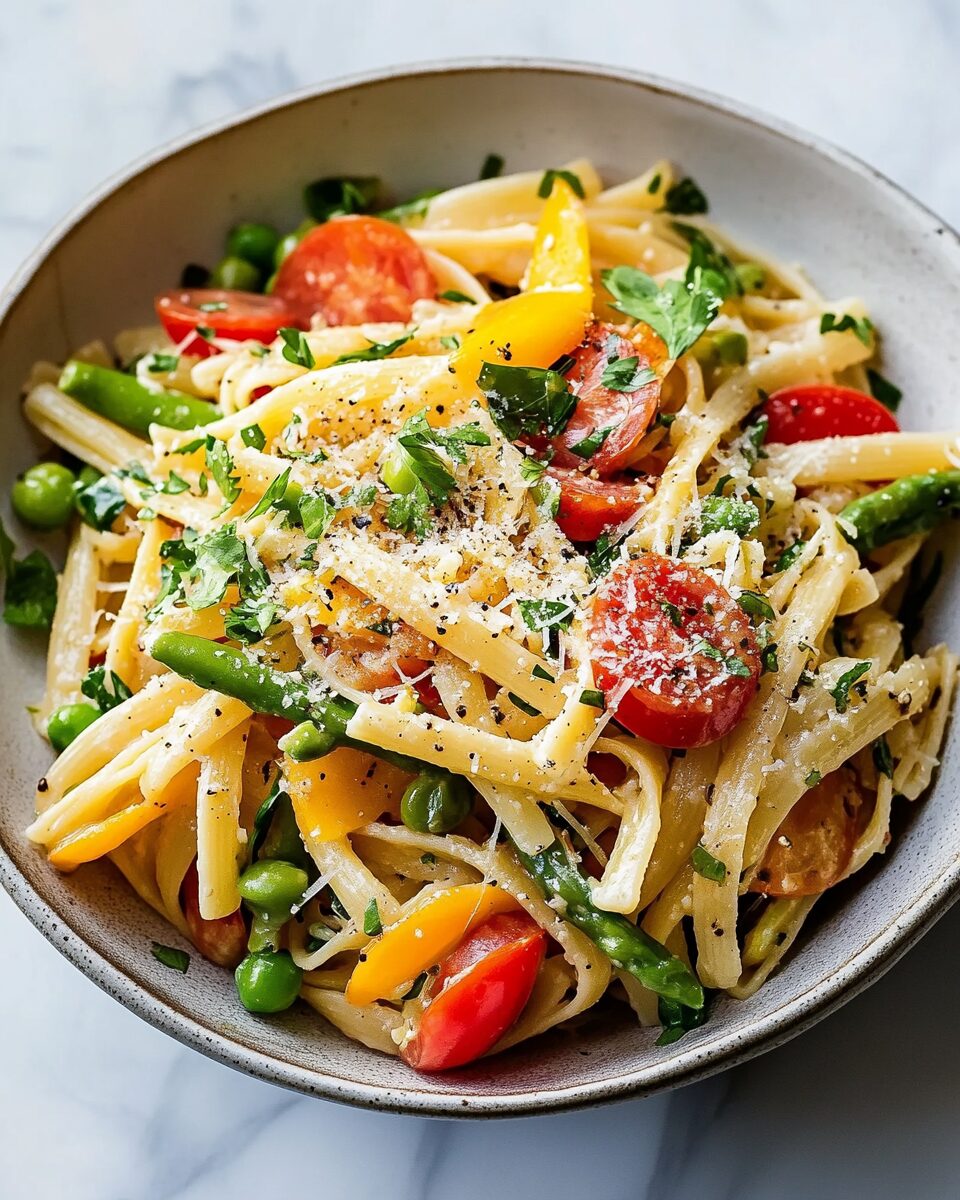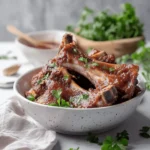“Primavera” means spring in Italian, but this dish is entirely American. Pasta primavera, loaded with vegetables in a light cream sauce, rose to popularity in the 1970s at New York’s Le Cirque restaurant. Our simple pasta primavera recipe with a creamy sauce and lots of vegetables is the perfect light and easy spring or summer dinner.
FULL RECIPE:
Ingredients
- 12 ounces penne pasta
- 2 tablespoons extra-virgin olive oil
- 1 large shallot, thinly sliced
- 2 medium carrots, thinly sliced
- 1 medium zucchini, halved lengthwise and thinly sliced
- 1 medium yellow squash, halved lengthwise and thinly sliced
- 2 tablespoons unsalted butter
- 1 cup freshly grated Parmesan cheese
- 1 cup whole milk
- 1 teaspoon dried basil
- 1 teaspoon garlic powder
- 1 teaspoon kosher salt
- ½ teaspoon freshly cracked black pepper
- 1 cup cherry tomatoes, halved
- ½ cup sun-dried tomatoes, thinly sliced
Directions
-
Cook the pasta: Bring a large pot of salted water to a boil over high heat. Add the penne and cook until al dente according to package instructions. Drain and set aside.
-
Sauté shallots and carrots: In a large skillet, heat the olive oil over medium heat. Add the shallot and carrots; cook, stirring occasionally, until softened, about 5 minutes. Transfer to a plate.
-
Cook zucchini and squash: In the same skillet, add the zucchini and yellow squash. Cook, stirring occasionally, until golden brown, about 5 minutes. Transfer to the plate with the shallots and carrots.
-
Prepare the sauce: In the same skillet, melt the butter over medium heat. Whisk in the Parmesan cheese, whole milk, dried basil, garlic powder, salt, and pepper until the sauce is smooth and creamy, about 2 minutes.
-
Combine ingredients: Stir in the cherry tomatoes and sun-dried tomatoes. Remove the skillet from heat. Add the cooked pasta and sautéed vegetables to the skillet; toss gently to combine, ensuring all components are evenly coated with the sauce.
-
Serve: Divide the pasta among bowls and serve immediately.
Nutrition Facts
- Serving Size: 1/6 of recipe
- Calories: 450
- Total Fat: 18g
- Saturated Fat: 8g
- Cholesterol: 35mg
- Sodium: 600mg
- Total Carbohydrates: 58g
- Dietary Fiber: 4g
- Sugars: 8g
- Protein: 15g
The Origins of Pasta Primavera
Pasta Primavera is a dish that embodies freshness, vibrancy, and the joy of seasonal vegetables. Despite its Italian name—“Primavera,” meaning “spring”—this dish originated in the United States. It gained popularity in the 1970s, particularly at the renowned New York restaurant Le Cirque. Unlike heavy, meat-based pasta dishes, Pasta Primavera celebrates vegetables, making it a light yet satisfying option.
Why Pasta Primavera is a Favorite
This dish has remained popular for decades due to its versatility and fresh flavors. It allows home cooks to experiment with different seasonal vegetables while keeping the preparation simple. The combination of lightly sautéed vegetables with a creamy or olive oil-based sauce creates a harmonious balance between richness and freshness. Whether served as a main dish or a side, Pasta Primavera appeals to those seeking a nutritious yet indulgent meal.
The Role of Vegetables in Pasta Primavera
Vegetables are the heart of this dish, bringing both color and texture. Traditional versions include zucchini, squash, bell peppers, carrots, and cherry tomatoes. However, the recipe is adaptable—any fresh vegetables can be used based on seasonality and preference. The key is to maintain a variety of textures, with some vegetables adding crunch while others become tender. This variety not only enhances the eating experience but also boosts the nutritional value of the dish.
The Importance of Sauce in Pasta Primavera
While vegetables are the highlight, the sauce plays a crucial role in tying the dish together. There are two common styles of sauce used in Pasta Primavera: a light cream-based sauce and an olive oil and garlic combination. The creamy version, made with butter, milk, and Parmesan, adds a rich, indulgent touch, while the olive oil-based version keeps it lighter and vegan-friendly. Whichever sauce is chosen, the goal is to coat the pasta without overpowering the freshness of the vegetables.
Best Pasta Choices for Pasta Primavera
The choice of pasta can greatly impact the dish’s texture and ability to hold the sauce. Penne is a popular option due to its tubular shape, which holds sauce well. Other good choices include fettuccine, farfalle, or rotini, as their ridges or curves help capture the sauce and bits of vegetables. Whole wheat or gluten-free pasta can also be used for dietary preferences.
Tips for Making the Perfect Pasta Primavera
- Use fresh, high-quality vegetables: Since vegetables are the star of the dish, they should be at their peak freshness for the best flavor and texture.
- Cook vegetables separately: Different vegetables have varying cooking times. Harder vegetables like carrots should be cooked first, while softer ones like tomatoes should be added at the end to prevent overcooking.
- Season well: Pasta Primavera benefits from simple yet effective seasoning, such as salt, pepper, garlic, and dried herbs like basil or oregano. A sprinkle of red pepper flakes can add a mild heat for extra depth.
- Don’t overcook the pasta: Al dente pasta is ideal, as it holds up better when mixed with the sauce and vegetables. Overcooked pasta can become mushy and ruin the texture of the dish.
- Save some pasta water: Reserving a bit of the starchy pasta water can help loosen the sauce and help it cling to the pasta more effectively.
Health Benefits of Pasta Primavera
Pasta Primavera is not just a delicious dish—it also provides a variety of health benefits. The assortment of vegetables supplies essential vitamins and minerals such as vitamin C, vitamin A, fiber, and antioxidants. The dish can be easily modified to suit different dietary needs, whether by reducing the cheese for a lower-fat version or using whole-grain pasta for added fiber. The balance of carbohydrates, healthy fats, and proteins makes it a well-rounded meal choice.
Variations of Pasta Primavera
One of the best things about Pasta Primavera is its adaptability. Here are some common variations:
- Protein Boost: Adding grilled chicken, shrimp, or tofu can turn Pasta Primavera into a protein-rich meal.
- Spicy Kick: Red pepper flakes or a drizzle of chili oil can add a subtle heat.
- Vegan Version: Using dairy-free butter, plant-based cheese, and almond or oat milk can create a fully vegan-friendly dish.
- Lemon Zest Twist: A bit of lemon zest or fresh lemon juice can enhance the freshness and brightness of the dish.
Pairing Suggestions
Pasta Primavera pairs well with a variety of sides and beverages:
- Wine Pairing: A crisp white wine like Sauvignon Blanc or Pinot Grigio complements the light, fresh flavors.
- Side Dishes: A simple green salad, garlic bread, or roasted asparagus can round out the meal.
- Dessert: A fruit sorbet or lemon tart provides a refreshing end to the meal.
Conclusion
Pasta Primavera is a timeless dish that combines the best of fresh vegetables, comforting pasta, and a flavorful yet light sauce. Its versatility allows for endless variations, making it a staple in many kitchens. Whether you prefer a creamy or olive oil-based version, this dish provides a nutritious and delicious way to enjoy pasta. Its origins as a fine-dining creation have transformed it into an everyday favorite that continues to bring a burst of color and flavor to the table.






